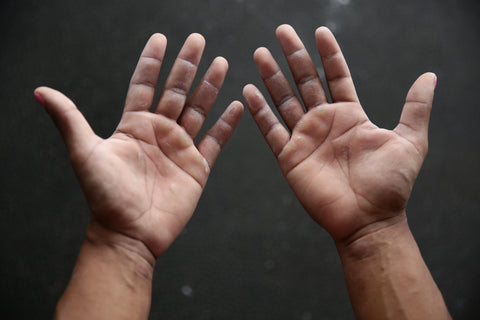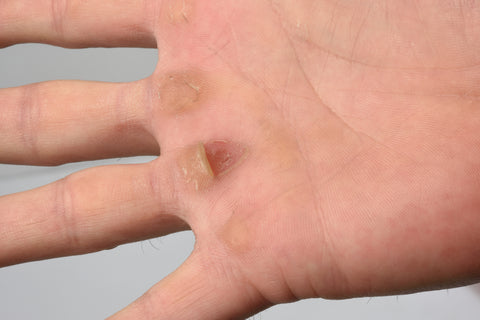The perspective that I am providing on this subject was formulated through my time as a gymnast, CrossFit training, and being a designer of gymnastics grips/hand protection for the sport of CrossFit. There are many activities that can cause your hands to rip. For the sake of specificity, I am focusing on the gymnastics based skills on the bar or rings a person would perform during CrossFit or competitive functional fitness. These skills include kipping and butterfly pull-ups, toes to bar, and bar or ring muscle-ups. My goal is to be as thorough as possible, but there is more opportunity for learning.
The main cause of rips to your hand is friction. The secondary causes are the condition of the skin of your hands, environmental conditions, and training volume and intensity. Each cause will be addressed and the ways to help prevent rips from happening.
FRICTION & CALLUSES

The definition of friction is "the resistance that one surface or object encounters when moving over another." When your hand is directly on the bar (with no barrier such as grips) your skin is shifting upon a fixed object (the bar) causing damage to the cells of the epidermis because it cannot handle mechanical insult. Depending on the degree of the friction it may result in a wound; aka a rip. As part of your body’s defense mechanism, it will change the cellular structure of the epidermis in order to be more resilient and form a callus. But you do not need to rip first in order to form a callus. Gradual and consistent pressure on the skin over time will form a callus. This is why it is good to progressively work up the volume and intensity to build up your skin. Just like your muscles, the skin of your hands will adapt to imposed demands and get stronger. But if the demands are too great at once it will cause damage and hinder your training. But it doesn’t end there...

THE IMPORTANCE OF MANAGING AND TREATING CALLUSES BEFORE THEY RIP
The calluses can actually cause you to rip too if you do not take care of them. If calluses get too big ridges can form causing a callus susceptible to getting ripped off. This is why it is good to file calluses so that they are smooth. It is important not to file them down too much that you take that callus down to nothing. It is good to have healthy smooth calluses to protect your hands. Moisturizing your hands is also good practice so that the skin of your hands does not become too dry and brittle. Moisturizing is especially important to do so in the winter because the cold weather makes your skin dry and the use of chalk in the gym compounds the issue. On the flip side in humid conditions, your hands can become excessively sweaty making your calluses too soft to be effective. Additionally, with sweaty hands, you will feel the need to over-grip, which makes the likelihood of ripping increase. So there is a balance that you need to maintain throughout the year.
TRAIN SMART: RIPPED HANDS ARE NOT A BADGE OF HONOR
Training volume is another factor to understand when it comes to the potential of ripping. Whenever you have an increase in volume you are imposing greater demands and your skin will have to adapt. In this case, you need to tune into how your hands are feeling in a workout. If they are starting to feel hot you need to start breaking up the reps and chip away with smaller sets. If you are doing large repetition sets of a skill the agitation and heat from the friction will build up and eventually you will rip. Then adding in intensity, such as in a competition setting where your adrenaline is pumping, you will naturally put more contraction into your grip increasing the friction thus the potential rip. In a training scenario if you feel like you are about to rip it best to stop before your skin rips open. Your hands will bounce back much quicker and not hinder your training in the days to come. However, in a competition setting, you need to know when to break up sets or be willing to sacrifice your hands.
Beyond allowing the strength of your skin to build up gradually, paying attention to its condition, and adjusting your approach to a given workout using the best type of grips for you will help prevent rips immensely. Some people call grips straps or gloves, but the correct name is grips. The truly most effective hand protection for the sport of CrossFit or functional fitness is grips designed specifically for these activities based on traditional gymnastics grips. It is important to note that grips are not a guarantee that you will not rip while wearing them, but they will reduce the possibility of ripping to a very significant degree.
GRIPS PROVIDE BENEFITS OF PROTECTION + PERFORMANCE
Grips provide a barrier between your hand and the apparatus, whether it is a pull-up bar or rings, which reduces friction on your hands.That is only one of the ways that grips protect your hands. Performance enhancement is actually the most important purpose of grips.The way grips improve performance is also another way they protect your hands.To keep it simple for this particular conversation grips create an ability to apply more torque on a bar, which also reduces the amount of strength needed to grip the bar and the amount your hand shifts during a particular skill. So to translate you can execute a skill with more efficiency and reduce your potential of ripping at the same time. Although grips will help protect you it is still important to practice good hand care as mentioned above.
At Victory Grips we have learned that one particular material and style of grips is not the best for every person and every scenario. We have different materials and styles to make sure we have the best options available to help you perform at your best and keep you protected. To understand which grips best suit you check out our grip finder quiz. If you have more questions after reading the information please reach out to us. We are here to help.






